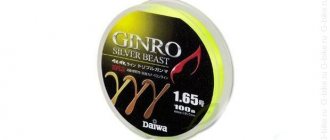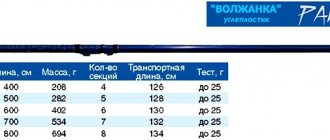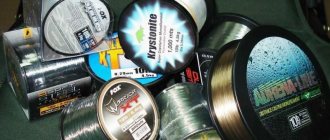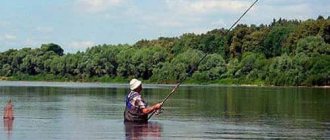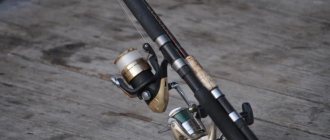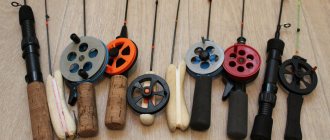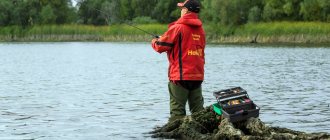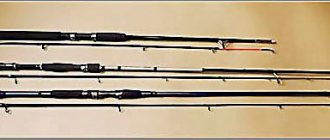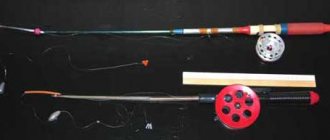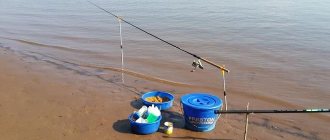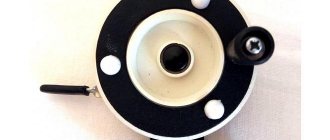Fishing Rods Review
08 February
Review of fishing rod lengths
The method of fishing depends on the length of the rod; the length of fishing rods can be short, up to 40 centimeters, or long up to eight meters. Short fishing rods are used for fishing in winter and fishing near the shore, while long ones are more versatile and are used at different times of the year.
The choice of fishing rod length also depends on the weight and size of the fish; the larger the trophy, the longer the fishing rod.
What types of fishing rods are there?
Let us immediately note that all proposed types of fishing rods for summer fishing are divided into composite and solid. The latter are convenient to use if you do not need to transport them. If you have to get to a pond by transport, then it will be more convenient to use composite fishing rods, which are small in size when folded. Composite fishing rods consist of several legs, the number of which can be from two to four.
Float fishing rods are the most popular. The advantage of such a fishing rod is its simplicity, reliability and ease of operation. Rods for float fishing are made of fiberglass, carbon fiber and bamboo.
A float rod has a lot of advantages, but what should be especially highlighted is the fact that with its help you can successfully catch absolutely any fish.
When choosing a fishing rod, special attention should be paid to the length of the cone attachment. You can find out the length as follows. We lay out the rod and examine it against the light.
Finnish fishing rods are considered the most reliable and high-quality, thanks to the tulip mounted on the rod of the tackle. You can use this fishing rod when fishing both from a boat and from the shore.
Choosing a fishing rod for summer fishing
At first glance, choosing a fishing rod does not present any particular difficulties. But, having come to the store, a novice fisherman sometimes gets lost among the variety of models presented. In order to make a decision faster, come to the store prepared. There are certain criteria by which fishing rods are selected:
1. Study the characteristics of the reservoir: depth, size, possible current. If the water is still, you will need one type of fishing rod; if the water is fast, completely different ones will be needed.
2. When going fishing, it is better to have an idea of what kind of fish is found in the reservoir. The size of the fish determines the choice of gear and its characteristics: action, test, length.
3. An important criterion for choosing a fishing rod is the method of fishing - from the shore or from a boat. As a rule, when fishing from a boat, shorter rods are required, while from the shore, longer rods are required.
All fishing rods have common components:
1. The “stick” itself calls the form.
2. Komel. Stiff part with handle.
3. The whip is exactly that part of the fishing rod that the angler casts.
4. Nod - the tip of the fishing rod, which gives a signal about a bite.
5. Passing rings. Located on the form for attaching the fishing line.
6. Reel (with fishing line).
7. Hook.
8. Bait.
9. Float.
In addition to common characteristics, fishing rods have many differences. There are several different types of fishing rods: float, fly, feeder, fly, spinning.
What material is the best fishing rod?
As noted, fishing rods can be made of fiberglass, bamboo, and carbon fiber. The most popular today are fishing rods made of carbon fiber. This is due to their many advantages, namely strength, lightness, convenience and reliability.
It is important to note that fiberglass fishing rods are also often used for fishing. Of course, in many characteristics these fishing rods are inferior to carbon fiber ones, but they are distinguished by high wear resistance and water resistance and, most importantly, these fishing rods are much cheaper than carbon fiber ones.
It should be noted that today a wide range of fishing rods are offered in the production of which graphite is used. These fishing rods are lightweight and flexible. The length of fishing rods of this type does not exceed 5 meters.
How to choose the right rod length
Today, rods with lengths from 1 to 7 and even 8 meters are offered. The choice of rod in terms of length should always be based on where you plan to fish, as well as what kind of fish. If the chosen place is surrounded by bushes and trees, then you should choose rod lengths for fishing from the shore in options up to 4 meters long. For fishing in open areas, you can use rods 5 or more meters long.
If fishing will be carried out on a lake with standing water, then a rod 4.5 meters long is best suited. When fishing on a river with a weak current, it is recommended to opt for five meters. It is important to note that in the latter case, the rod must be of a rigid action and must have a thick tip. If fishing will be carried out on reservoirs or large lakes, where it is important to cast the bait far from the shore, preference should be given to feeder rods with a flexible tip.
Choosing a fishing rod based on the quality of the reel seat and guides
It is important to note that high-quality guide rings help reduce friction of the fishing line on the inside of the ring, which has a positive effect on casting and landing fish. The following types of guide rings can be installed on fishing rods: with inserts and chrome-plated.
Insert guides are strong and durable, but they do not minimize line friction. Chrome rings do not have a long service life; as a rule, it is recommended to replace them with new ones every season. The main advantage of chrome rings is only to reduce friction.
When choosing, it is important to pay attention to the quality and reliability of the existing reel seat. It is important that after installing the coil, it fits comfortably in your hand and is clearly fixed in its place.
When choosing, it is important to carefully examine the integrity of the existing guide rings; their surface should not have dents, cracks, chips or other defects. In addition, the rings should not wobble and, most importantly, the rings and reel seat should be installed strictly in line.
General principles of selection
The rod is the basis of any fishing rod. In its most simplified form, it is a cone-shaped pole, the wide end of which the fisherman holds in his hands, and the fishing line is lowered from the narrow end. This device must meet certain requirements:
- Strength. Don't underestimate the strength and mass of large fish. Some specimens are quite capable of not only breaking a fishing rod, but also dragging the fisherman himself into the water. The rod should not break even if the equipment gets caught on a foreign object.
- Durability. A good fishing rod is expensive, so it is irrational to buy gear for one season.
- Ergonomics. Fishing is a hobby for the patient. To catch fish, you often have to spend several hours in the cold and damp. Bad gear will turn this type of outdoor activity into torture. The rod should lie comfortably in the hands and quickly respond to all movements of its owner.
- Functionality. Each fishing method requires specially designed gear. There is no need to even try to use a fishing rod that is unsuitable for the purpose when creating a fishing rod.
Advice. Some novice and cash-strapped fishermen use various available means as a fishing rod (primarily even branches of suitable length and thickness). This is not the best idea. “Good” is not always synonymous with “expensive.” Many brands of branded fishing rods are affordable, practical and, most importantly, radically change the experience of the entire fishing process.
What is a fishing rod build?
It all depends on where and what kind of fish you plan to catch. So, to catch fish whose weight does not exceed 1 kg, it is enough to purchase a 6-meter fly rod, which can be made of fiberglass or carbon fiber. A fly fishing rod can only have a fast action, which means that only its tip will bend when subjected to load.
To catch large fish, you should buy a rod that is durable and preferably with a slow action. This rod is distinguished by the fact that it bends along its entire length, due to which the load will be distributed evenly. It is important to note that slow action rods must be equipped with a quality reel.
Match fishing rod
First of all, this is a tackle for long-distance, ultra-long casting with great accuracy. Match fishing rods are equipped with high-quality guides and consist of several parts with plug connections. The main distinguishing feature of the “matches” is an accurate test of the cast equipment (total mass of the float, sinkers, hook and nozzle). As a rule, such rods have a length of 3.5-5.5 meters. They are indispensable for fishing from depth and at a great distance, up to 80 meters, from the shore. A distinctive feature of match rods is the presence of many small guide rings - this ensures uniform distribution of the load on the tip along the entire length of the rod and prevents wet line from sticking to the blank. The form is usually made of three parts. Rods for match fishing are divided into three groups of tests that correspond to the power classes of the rod: light, medium and heavy. This also determines the structure of the rod - from soft to hard. On match rods, the butt has an elongated shape for ease of maneuvering and the possibility of a two-handed grip when casting. For such casts when fishing with match rods, rather heavy equipment with sliding, sometimes partially self-supporting, floats is used. A special case of using a match rod is a carp rod, including a feeder rod, which is distinguished by the presence of a feeder sinker. In this case, the float is not used; the bite alarm is served by the sensitive tip of the fishing rod and various sound and mechanical devices (electronic alarms, bells, “monkeys”, etc.). Such rods are usually much more powerful, with a cast of up to 100-150 g.
Reels for match fishing rods
Due to the peculiarities of fishing techniques with a match fishing rod, special spinning reels are produced for them. Since fishing involves the use of thin fishing line, the reel spool has a small depth and diameter to completely fill it without the use of rewinding. This, in addition, makes it easier to remove the line when casting, since when winding onto a deep spool, a thin line under load can fall between the lower turns, which causes a lot of trouble and can even lead to breakage of the tackle. The gear ratio of a match reel is significantly higher compared to a classic spinning reel, and the friction brake is much smoother and more accurately adjustable. You should have several spare spools with fishing line of different diameters for different fishing conditions.
Float for fishing with match tackle
To fish with a match fishing rod, you need floats for long casts. This type
The float will ensure precise delivery of the bait to the fishing point. The most suitable floats for these purposes are “Wagler” , which have a long body without a keel and a long antenna. Wagler floats have their own partial weight and one ring of the lower body. The adjustable retainer for such floats is a tube made of elastic material with a micro-carabiner that hooks onto the float ring. The float's own weight can be permanent, removable and even adjustable using a set of ring weights. The markings on the body of the waggler indicate the weight of the sinkers required to fully load the tackle. A properly loaded float raises above the surface only the very tip of the antenna, 1-4 cm long, painted in bright, contrasting colors for visibility.

If it is necessary to lower the bait to a depth of half or more than the length of the match rod, the float is attached in a sliding manner using stoppers, as described in the section on the Bolognese fishing rod above. It is also necessary to install a small swivel at the junction of the main line with the leash to avoid twisting of the tackle when reeling in or in the current. It is also worth noting that equipment with a rigidly fixed (blind) float mount is simpler and more convenient to use. It is much more sensitive to bites from cautious fish, however, the maximum possible fishing depth in this case does not exceed 1/3-1/2 the length of the match rod.
What line to use for match fishing
For fishing with a match rod, special monofilament fishing lines are used. Basic requirements for such a fishing line: - high strength with a minimum diameter; — the fishing line must be sinking; — lack of “shape memory” effect. The cross-section of the main line is selected depending on the distance to the fishing point, the weight of the equipment and the size of the intended fish. As a rule, fishing lines with a cross section of 0.14-0.18 mm are used, less often up to 0.20 mm. Sometimes it makes sense to use colored fishing line to make the tackle less noticeable.
Features of fishing with a match rod
Considering the use of long casts, fishing with a match fishing rod requires sufficient space to maneuver the tackle, so before casting you should make sure that nothing will interfere with this. Be sure to adjust the reel friction brake in advance. Its trigger force is set to approximately 50% of the breaking load of the fishing line used. After casting and splashing down the tackle, immediately lower the tip of the rod into the water - this way the line will sink faster, which will reduce the influence of wind and waves on the tackle. It is also necessary to take into account that floats for match fishing are coarser and heavier, they are less sensitive to bites from cautious fish than light fly floats and therefore require more attention and experience from the angler.
We hope that this article will help a novice fisherman understand all the intricacies of float fishing and decide what gear to prepare for the upcoming fishing on Akhtuba. Moreover, from April 20, spring spawning restrictions on recreational fishing begin to apply, and fishing from the shore with a float rod or donka with two hooks per person during this period can be done almost everywhere. Welcome to Three Rivers!
More about fishing on Akhtuba:
Fishing on Akhtuba in spring
Modern float tackle for fishing on the Volga. Part II
Different types and methods of bait attachments
Fishing on Akhtuba in April
For roach in the spring on Akhtuba
Fishing with a float on the current in the riverbeds of the Lower Volga
Where and how to catch rudd on Akhtuba - fishing with a float
How to Preserve Worms for Fishing
Spring fishing in Trekhrechye: what to expect from fishing?
Fishing on Akhtuba in May
We catch buffalo in Trekhrechye in the spring from April and summer
Choosing a modern inertia-free spinning reel
Catching bream on Akhtuba with a float rod and bottom tackle
We conjure a universal fishing attachment - semolina (fishing secrets)
Main types of spinning rods and their features
Steamed peas are an excellent bait for summer fishing for carp and bream
Fishing in Astrakhan
Fishing on the Lower Volga in April: where, who and how to catch
Catching April roach on Akhtuba
Lower Volga crucian carp: what to use to catch the cunning fish?
Tackle for bottom fishing for white fish in Trekhrechye on Akhtuba
What should be the strength and thickness of a fishing rod?
So, the choice of fishing rod regarding strength and thickness should always be made based on what kind of fish you plan to catch. A short and thin rod is perfect for catching small fish in difficult conditions. The main requirement for a fishing rod is that it should be as flexible as possible.
large fish, for example, carp , with a rod up to 4 meters long, which will be durable and able to withstand heavy loads. Roach , rudd and other fish whose weight does not exceed 2 kg can be conveniently caught using fiberglass fishing rods, the length of which should be selected based on the fishing conditions.
Provided that the requirements for choosing a fishing rod are met exactly, you are guaranteed to be able to purchase a fishing rod and fishing tackle that will fully satisfy your needs and is ideal for fishing in specific conditions.
And finally:
